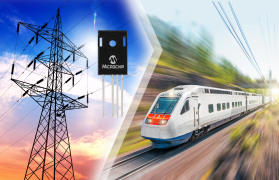Microchip Technology Inc. has expanded its silicon carbide (SiC) portfolio with the introduction of 3.3-kV SiC MOSFETs and SiC Schottky barrier diodes (SBC), claiming the industry’s lowest on-resistance 3.3-kV SiC MOSFETs and highest current-rated SiC SBDs available in the market. These devices target high-voltage power electronics in electrified transportation, renewable energy, aerospace, and industrial applications. These include traction power units (TPUs), auxiliary power units (APUs), solid-state transformers (SSTs) industrial motor drives, and energy infrastructure solutions.
SiC adoption has been relatively slow but it is starting to take off, said Rob Weber, product line director, Silicon Carbide Solutions, Microchip Technology. Customers have a lot of excitement about it but also a lot of concerns, he added.
Until now the availability of 3.3 kV-SiC power devices has been limited. This 3.3-kV offering fits into Microchip’s philosophy of being more of a provider of solutions than components and strategy to help customers adopt SiC with ease, speed, and confidence, Weber said.
Microchip helps customers adopt SiC in three ways – lower system cost by eliminating redundancy, faster development, and lower risk.
SiC compared to silicon is more expensive but the system cost is where the benefit of SiC comes in, and Microchip does that by focusing heavily on ruggedness and performance, so customers do not have to build in redundancy, said Weber. Second, adopting SiC requires working with customers on a systems approach that helps speed development, and third is lowering risk, which Microchip does by using a dual-fab strategy and sourcing epi wafers from multiple sources, he said.
In addition, Microchip does not have an end-of-life practice, supporting some customers up to 20 to 25 years. “When you look at the long-term cost of having to redesign a product because of a change in the components, we help reduce if not eliminate that risk for customers, which is especially important in industrial equipment that have 10 to 20-year lifespans,” he said.
As part of the company’s approach to solving customer challenges, Microchip continues to extend its SiC product offering. With the introduction of the 3.3-kV MOSFETs and SBDs, Microchip now offers SiC devices with voltage ratings from 700 V to 3.3 kV in die, discretes, and modules, along with digital gate drivers. Microchip will also customize the modules.

Microchip 3.3-kV SiC MOSFET and diode parts. Click for a larger image. (Source: Microchip Technology Inc.)
Joining Microchip’s SiC family that includes 700-V, 1200-V and 1700-V products, the five initial 3.3-kV devices include three MOSFETS that offer 25 mOhm to 400 mOhm on-resistance, or RDS(on), with rated current of 104 A, 43 A, and 8 A, and two SBDs rated at 30 A and 90 A. Microchip claims the new 3.3-kV SiC MOSFETs provide the industry’s lowest on resistance at 25 mOhm and the SBDs offer the industry’s highest current rating of 90 amps. The 3.3-kV MOSFETs and SBDs are available in die or package form.
Weber said the 3.3-kV devices are helping customers reduce design complexity and overall cost. “The 3.3-kV IGBT is very well accepted for high-voltage DC applications, train traction applications, and medium-voltage drives, but IGBTs are very slow in their switching capability, and have very high switching losses,” he explained. “SiC provides the ability to switch faster and by doing that we’re able to help eliminate a lot of design compromises that you would do otherwise, while also reducing the design complexity.”
The benefits come into play in the transition to SiC, leveraging the technology’s inherent advantages, and offering a 3.3-kV device that can replace two 1700-V devices in series, as an example.
The 3.3-kV devices enable customers to reduce the size, weight, and and other losses, which is an efficiency metric by moving into this voltage class, said Weber, and lastly, there aren’t that many suppliers of 3.3-kV devices. “We’re looking to fill that gap for customers in rail, medical imaging, semiconductor capital equipment, renewable energy and the grid, industrial motor drives particularly medium-voltage drives, and aerospace and defense power distribution as some of the key markets.”
As part of the company’s focus on ruggedness, performance, and reliability, the SiC devices deliver very high gate oxide integrity (100+ years), degradation-free and robust body diodes, as well as strong avalanche ruggedness, delivering stable performance after 100K pulses, and short-circuit protection, which is very key in SiC because it is more susceptible to circuit damage than IGBTs, said Weber.
The SiC products can be combined with Microchip’s other devices including 8-, 16- and 32-bit microcontrollers (MCUs), power management devices, analog sensors, touch and gesture controllers, and wireless connectivity solutions to create complete system solutions.
The expanded SiC portfolio is supported by a range of SiC SPICE models compatible with Microchip’s MPLAB Mindi analog simulator modules and driver board reference designs are available. In addition, the Intelligent Configuration Tool (ICT) enables designers to model SiC gate driver settings for Microchip’s AgileSwitch family of configurable digital gate drivers.
The 3.3-kV SiC MOSFETs and SBDs are available in die and package options. They are available now in production volumes.
















